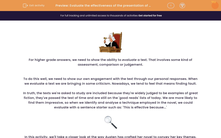
For higher grade answers, we need to show the ability to evaluate a text. That involves some kind of assessment, comparison or judgement.
To do this well, we need to show our own engagement with the text through our personal responses. When we evaluate a text we are bringing in some criticism. Nowadays, we tend to feel that means finding fault.
In truth, the texts we're asked to study are included because they're widely judged to be examples of great fiction, they've passed the test of time and are still on the 'good reads' lists of today. We are more likely to find them impressive, so when we identify and analyse a technique employed in the novel, we could evaluate with a sentence starter such as: 'This is effective because...'

In this activity, we'll take a closer look at the way Austen has crafted her novel to convey her key themes, the ideas she explores through her characters and their stories. We should remember that we call these 'conscious constructs'; the characters behave in a way controlled by the author.
In particular, we'll want to consider how the author's style contributes to the meaning, or themes.
Here we'll consider aspects of how Austen's characters' development reflect the novel's themes, and touch on the way information is revealed through dialogue and letters too.
You should always refer to your own copy of the book when working through the activities. The quotations are for reference only.







